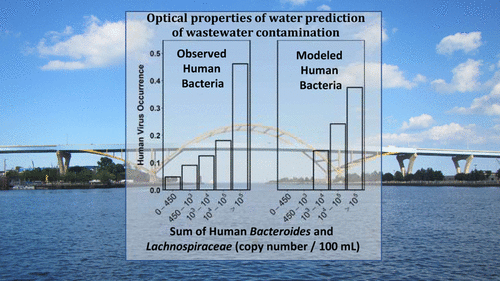当前位置:
X-MOL 学术
›
Environ. Sci. Technol.
›
论文详情
Our official English website, www.x-mol.net, welcomes your
feedback! (Note: you will need to create a separate account there.)
Optical Properties of Water for Prediction of Wastewater Contamination, Human-Associated Bacteria, and Fecal Indicator Bacteria in Surface Water at Three Watershed Scales
Environmental Science & Technology ( IF 10.8 ) Pub Date : 2021-09-30 , DOI: 10.1021/acs.est.1c02644 Steven R Corsi 1 , Laura A De Cicco 1 , Angela M Hansen 2 , Peter L Lenaker 1 , Brian A Bergamaschi 2 , Brian A Pellerin 3 , Debra K Dila 4 , Melinda J Bootsma 4 , Susan K Spencer 5 , Mark A Borchardt 5 , Sandra L McLellan 4
Environmental Science & Technology ( IF 10.8 ) Pub Date : 2021-09-30 , DOI: 10.1021/acs.est.1c02644 Steven R Corsi 1 , Laura A De Cicco 1 , Angela M Hansen 2 , Peter L Lenaker 1 , Brian A Bergamaschi 2 , Brian A Pellerin 3 , Debra K Dila 4 , Melinda J Bootsma 4 , Susan K Spencer 5 , Mark A Borchardt 5 , Sandra L McLellan 4
Affiliation

|
Relations between spectral absorbance and fluorescence properties of water and human-associated and fecal indicator bacteria were developed for facilitating field sensor applications to estimate wastewater contamination in waterways. Leaking wastewater conveyance infrastructure commonly contaminates receiving waters. Methods to quantify such contamination can be time consuming, expensive, and often nonspecific. Human-associated bacteria are wastewater specific but require discrete sampling and laboratory analyses, introducing latency. Human sewage has fluorescence and absorbance properties different than those of natural waters. To assist real-time field sensor development, this study investigated optical properties for use as surrogates for human-associated bacteria to estimate wastewater prevalence in environmental waters. Three spatial scales were studied: Eight watershed-scale sites, five subwatershed-scale sites, and 213 storm sewers and open channels within three small watersheds (small-scale sites) were sampled (996 total samples) for optical properties, human-associated bacteria, fecal indicator bacteria, and, for selected samples, human viruses. Regression analysis indicated that bacteria concentrations could be estimated by optical properties used in existing field sensors for watershed and subwatershed scales. Human virus occurrence increased with modeled human-associated bacteria concentration, providing confidence in these regressions as surrogates for wastewater contamination. Adequate regressions were not found for small-scale sites to reliably estimate bacteria concentrations likely due to inconsistent local sanitary sewer inputs.
中文翻译:

用于预测三个流域尺度地表水中废水污染、人类相关细菌和粪便指示菌的水的光学特性
开发了水与人类相关和粪便指示菌的光谱吸收和荧光特性之间的关系,以促进现场传感器应用以估计水道中的废水污染。泄漏的废水输送基础设施通常会污染受纳水体。量化此类污染的方法可能既费时又昂贵,而且通常是非特异性的。人类相关细菌是废水特有的,但需要离散采样和实验室分析,从而导致潜伏期。人类污水具有不同于天然水的荧光和吸收特性。为了协助实时现场传感器的开发,本研究调查了用作人类相关细菌替代品的光学特性,以估计环境水域中废水的流行程度。研究了三个空间尺度:对八个流域尺度站点、五个亚流域尺度站点以及三个小流域(小尺度站点)内的 213 条雨水管和明渠进行了采样(共 996 个样本),用于光学特性、人类相关细菌、粪便指示菌,以及对于选定的样本,人类病毒。回归分析表明细菌浓度可以通过用于流域和亚流域尺度的现有现场传感器中使用的光学特性来估计。人类病毒的发生率随着模拟的人类相关细菌浓度而增加,为这些回归作为废水污染的替代物提供了信心。由于当地卫生下水道输入不一致,小规模场所没有找到足够的回归来可靠地估计细菌浓度。对 8 个流域规模站点、5 个亚流域规模站点以及 3 个小流域(小规模站点)内的 213 条雨水管和明渠进行了采样(共 996 个样本)的光学特性、人类相关细菌、粪便指示菌和,对于选定的样本,人类病毒。回归分析表明细菌浓度可以通过用于流域和亚流域尺度的现有现场传感器中使用的光学特性来估计。人类病毒的发生率随着模拟的人类相关细菌浓度而增加,为这些回归作为废水污染的替代物提供了信心。由于当地卫生下水道输入不一致,小规模场所没有找到足够的回归来可靠地估计细菌浓度。对 8 个流域规模站点、5 个亚流域规模站点以及 3 个小流域(小规模站点)内的 213 条雨水管和明渠进行了采样(共 996 个样本)的光学特性、人类相关细菌、粪便指示菌和,对于选定的样本,人类病毒。回归分析表明细菌浓度可以通过用于流域和亚流域尺度的现有现场传感器中使用的光学特性来估计。人类病毒的发生率随着模拟的人类相关细菌浓度而增加,为这些回归作为废水污染的替代物提供了信心。由于当地卫生下水道输入不一致,小规模场所没有找到足够的回归来可靠地估计细菌浓度。对三个小流域(小规模地点)内的 213 条雨水管和明渠进行了采样(共 996 个样本),用于检测光学特性、人类相关细菌、粪便指示菌以及选定样本中的人类病毒。回归分析表明细菌浓度可以通过用于流域和亚流域尺度的现有现场传感器中使用的光学特性来估计。人类病毒的发生率随着模拟的人类相关细菌浓度而增加,为这些回归作为废水污染的替代物提供了信心。由于当地卫生下水道输入不一致,小规模场所没有找到足够的回归来可靠地估计细菌浓度。对三个小流域(小规模地点)内的 213 条雨水管和明渠进行了采样(共 996 个样本),用于检测光学特性、人类相关细菌、粪便指示菌,以及选定样本中的人类病毒。回归分析表明细菌浓度可以通过用于流域和亚流域尺度的现有现场传感器中使用的光学特性来估计。人类病毒的发生率随着模拟的人类相关细菌浓度而增加,为这些回归作为废水污染的替代物提供了信心。由于当地卫生下水道输入不一致,小规模场所没有找到足够的回归来可靠地估计细菌浓度。
更新日期:2021-10-19
中文翻译:

用于预测三个流域尺度地表水中废水污染、人类相关细菌和粪便指示菌的水的光学特性
开发了水与人类相关和粪便指示菌的光谱吸收和荧光特性之间的关系,以促进现场传感器应用以估计水道中的废水污染。泄漏的废水输送基础设施通常会污染受纳水体。量化此类污染的方法可能既费时又昂贵,而且通常是非特异性的。人类相关细菌是废水特有的,但需要离散采样和实验室分析,从而导致潜伏期。人类污水具有不同于天然水的荧光和吸收特性。为了协助实时现场传感器的开发,本研究调查了用作人类相关细菌替代品的光学特性,以估计环境水域中废水的流行程度。研究了三个空间尺度:对八个流域尺度站点、五个亚流域尺度站点以及三个小流域(小尺度站点)内的 213 条雨水管和明渠进行了采样(共 996 个样本),用于光学特性、人类相关细菌、粪便指示菌,以及对于选定的样本,人类病毒。回归分析表明细菌浓度可以通过用于流域和亚流域尺度的现有现场传感器中使用的光学特性来估计。人类病毒的发生率随着模拟的人类相关细菌浓度而增加,为这些回归作为废水污染的替代物提供了信心。由于当地卫生下水道输入不一致,小规模场所没有找到足够的回归来可靠地估计细菌浓度。对 8 个流域规模站点、5 个亚流域规模站点以及 3 个小流域(小规模站点)内的 213 条雨水管和明渠进行了采样(共 996 个样本)的光学特性、人类相关细菌、粪便指示菌和,对于选定的样本,人类病毒。回归分析表明细菌浓度可以通过用于流域和亚流域尺度的现有现场传感器中使用的光学特性来估计。人类病毒的发生率随着模拟的人类相关细菌浓度而增加,为这些回归作为废水污染的替代物提供了信心。由于当地卫生下水道输入不一致,小规模场所没有找到足够的回归来可靠地估计细菌浓度。对 8 个流域规模站点、5 个亚流域规模站点以及 3 个小流域(小规模站点)内的 213 条雨水管和明渠进行了采样(共 996 个样本)的光学特性、人类相关细菌、粪便指示菌和,对于选定的样本,人类病毒。回归分析表明细菌浓度可以通过用于流域和亚流域尺度的现有现场传感器中使用的光学特性来估计。人类病毒的发生率随着模拟的人类相关细菌浓度而增加,为这些回归作为废水污染的替代物提供了信心。由于当地卫生下水道输入不一致,小规模场所没有找到足够的回归来可靠地估计细菌浓度。对三个小流域(小规模地点)内的 213 条雨水管和明渠进行了采样(共 996 个样本),用于检测光学特性、人类相关细菌、粪便指示菌以及选定样本中的人类病毒。回归分析表明细菌浓度可以通过用于流域和亚流域尺度的现有现场传感器中使用的光学特性来估计。人类病毒的发生率随着模拟的人类相关细菌浓度而增加,为这些回归作为废水污染的替代物提供了信心。由于当地卫生下水道输入不一致,小规模场所没有找到足够的回归来可靠地估计细菌浓度。对三个小流域(小规模地点)内的 213 条雨水管和明渠进行了采样(共 996 个样本),用于检测光学特性、人类相关细菌、粪便指示菌,以及选定样本中的人类病毒。回归分析表明细菌浓度可以通过用于流域和亚流域尺度的现有现场传感器中使用的光学特性来估计。人类病毒的发生率随着模拟的人类相关细菌浓度而增加,为这些回归作为废水污染的替代物提供了信心。由于当地卫生下水道输入不一致,小规模场所没有找到足够的回归来可靠地估计细菌浓度。











































 京公网安备 11010802027423号
京公网安备 11010802027423号